Taxation and Profit Schemes
VerifiedAdded on 2020/01/07
|9
|2665
|139
Essay
AI Summary
This assignment analyzes the legal case of *Anor v FC of T* (98 ATC 4487), focusing on how the court ruled on the taxation of profits derived from property sales within a profit-making scheme. The document explores the concept of commercial dealings and highlights that profits gained through such schemes are considered taxable income, even if not directly generated from a traditional business operation.
Contribute Materials
Your contribution can guide someone’s learning journey. Share your
documents today.
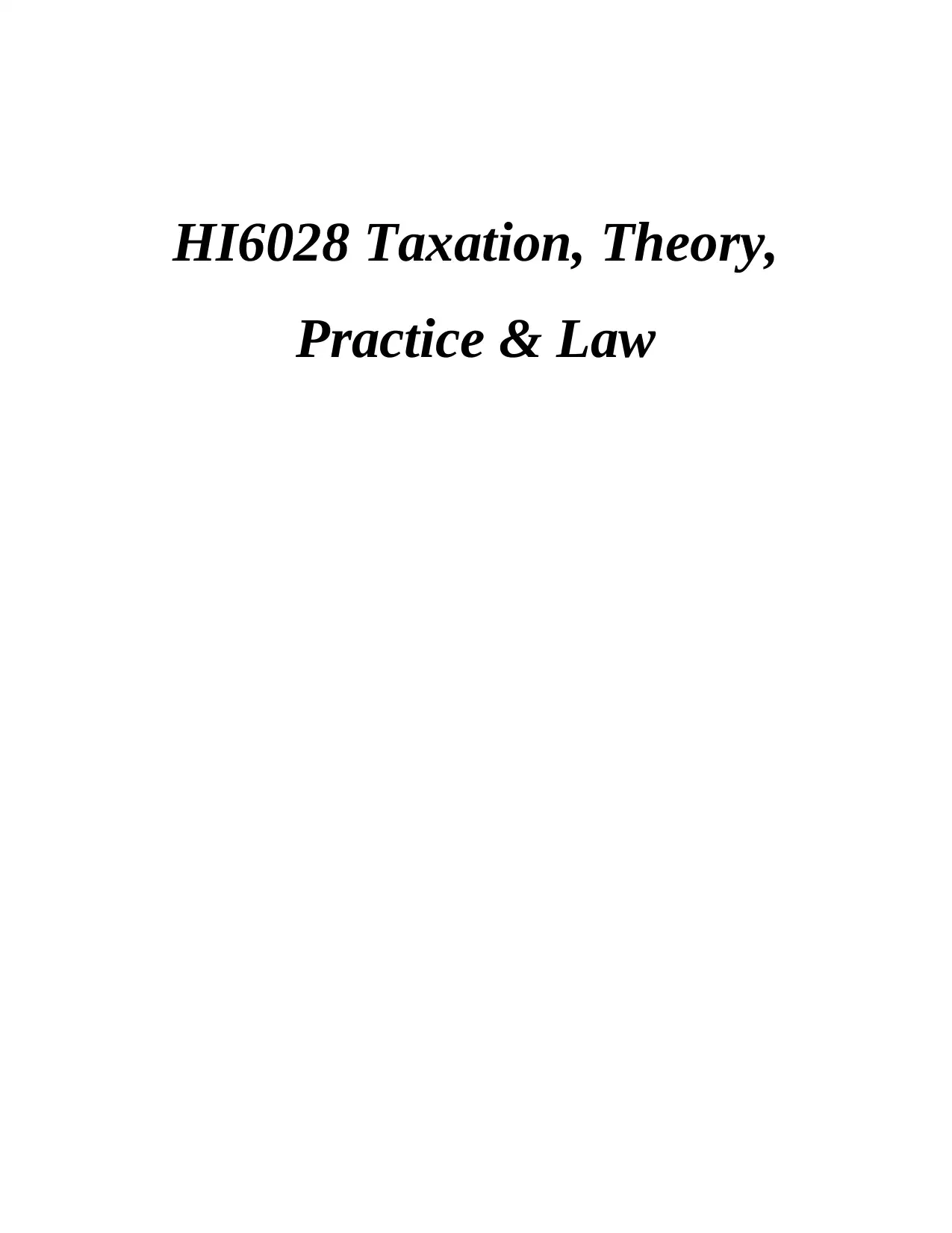
HI6028 Taxation, Theory,
Practice & Law
Practice & Law
Secure Best Marks with AI Grader
Need help grading? Try our AI Grader for instant feedback on your assignments.
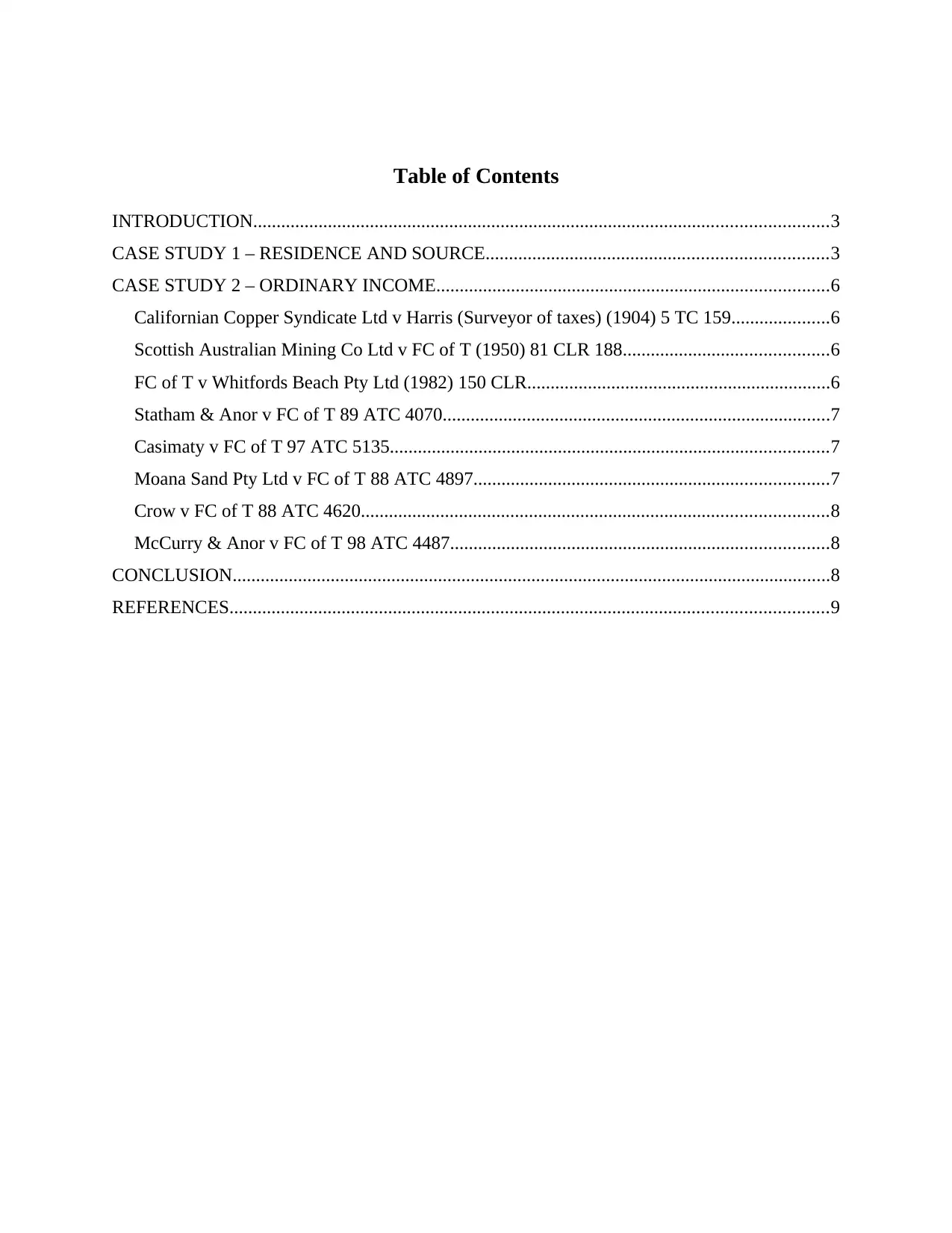
Table of Contents
INTRODUCTION...........................................................................................................................3
CASE STUDY 1 – RESIDENCE AND SOURCE.........................................................................3
CASE STUDY 2 – ORDINARY INCOME....................................................................................6
Californian Copper Syndicate Ltd v Harris (Surveyor of taxes) (1904) 5 TC 159.....................6
Scottish Australian Mining Co Ltd v FC of T (1950) 81 CLR 188............................................6
FC of T v Whitfords Beach Pty Ltd (1982) 150 CLR.................................................................6
Statham & Anor v FC of T 89 ATC 4070...................................................................................7
Casimaty v FC of T 97 ATC 5135..............................................................................................7
Moana Sand Pty Ltd v FC of T 88 ATC 4897............................................................................7
Crow v FC of T 88 ATC 4620....................................................................................................8
McCurry & Anor v FC of T 98 ATC 4487.................................................................................8
CONCLUSION................................................................................................................................8
REFERENCES................................................................................................................................9
INTRODUCTION...........................................................................................................................3
CASE STUDY 1 – RESIDENCE AND SOURCE.........................................................................3
CASE STUDY 2 – ORDINARY INCOME....................................................................................6
Californian Copper Syndicate Ltd v Harris (Surveyor of taxes) (1904) 5 TC 159.....................6
Scottish Australian Mining Co Ltd v FC of T (1950) 81 CLR 188............................................6
FC of T v Whitfords Beach Pty Ltd (1982) 150 CLR.................................................................6
Statham & Anor v FC of T 89 ATC 4070...................................................................................7
Casimaty v FC of T 97 ATC 5135..............................................................................................7
Moana Sand Pty Ltd v FC of T 88 ATC 4897............................................................................7
Crow v FC of T 88 ATC 4620....................................................................................................8
McCurry & Anor v FC of T 98 ATC 4487.................................................................................8
CONCLUSION................................................................................................................................8
REFERENCES................................................................................................................................9
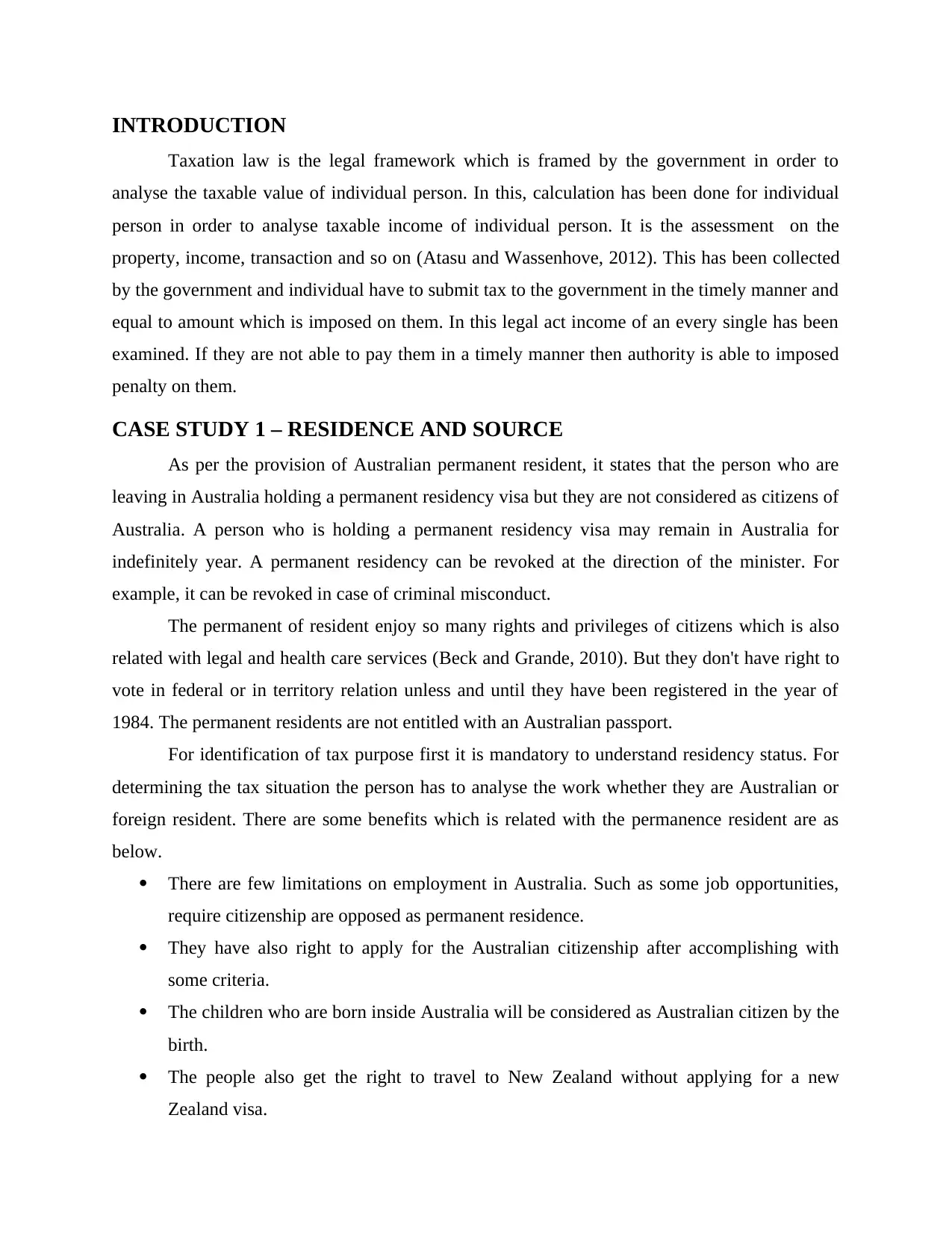
INTRODUCTION
Taxation law is the legal framework which is framed by the government in order to
analyse the taxable value of individual person. In this, calculation has been done for individual
person in order to analyse taxable income of individual person. It is the assessment on the
property, income, transaction and so on (Atasu and Wassenhove, 2012). This has been collected
by the government and individual have to submit tax to the government in the timely manner and
equal to amount which is imposed on them. In this legal act income of an every single has been
examined. If they are not able to pay them in a timely manner then authority is able to imposed
penalty on them.
CASE STUDY 1 – RESIDENCE AND SOURCE
As per the provision of Australian permanent resident, it states that the person who are
leaving in Australia holding a permanent residency visa but they are not considered as citizens of
Australia. A person who is holding a permanent residency visa may remain in Australia for
indefinitely year. A permanent residency can be revoked at the direction of the minister. For
example, it can be revoked in case of criminal misconduct.
The permanent of resident enjoy so many rights and privileges of citizens which is also
related with legal and health care services (Beck and Grande, 2010). But they don't have right to
vote in federal or in territory relation unless and until they have been registered in the year of
1984. The permanent residents are not entitled with an Australian passport.
For identification of tax purpose first it is mandatory to understand residency status. For
determining the tax situation the person has to analyse the work whether they are Australian or
foreign resident. There are some benefits which is related with the permanence resident are as
below.
There are few limitations on employment in Australia. Such as some job opportunities,
require citizenship are opposed as permanent residence.
They have also right to apply for the Australian citizenship after accomplishing with
some criteria.
The children who are born inside Australia will be considered as Australian citizen by the
birth.
The people also get the right to travel to New Zealand without applying for a new
Zealand visa.
Taxation law is the legal framework which is framed by the government in order to
analyse the taxable value of individual person. In this, calculation has been done for individual
person in order to analyse taxable income of individual person. It is the assessment on the
property, income, transaction and so on (Atasu and Wassenhove, 2012). This has been collected
by the government and individual have to submit tax to the government in the timely manner and
equal to amount which is imposed on them. In this legal act income of an every single has been
examined. If they are not able to pay them in a timely manner then authority is able to imposed
penalty on them.
CASE STUDY 1 – RESIDENCE AND SOURCE
As per the provision of Australian permanent resident, it states that the person who are
leaving in Australia holding a permanent residency visa but they are not considered as citizens of
Australia. A person who is holding a permanent residency visa may remain in Australia for
indefinitely year. A permanent residency can be revoked at the direction of the minister. For
example, it can be revoked in case of criminal misconduct.
The permanent of resident enjoy so many rights and privileges of citizens which is also
related with legal and health care services (Beck and Grande, 2010). But they don't have right to
vote in federal or in territory relation unless and until they have been registered in the year of
1984. The permanent residents are not entitled with an Australian passport.
For identification of tax purpose first it is mandatory to understand residency status. For
determining the tax situation the person has to analyse the work whether they are Australian or
foreign resident. There are some benefits which is related with the permanence resident are as
below.
There are few limitations on employment in Australia. Such as some job opportunities,
require citizenship are opposed as permanent residence.
They have also right to apply for the Australian citizenship after accomplishing with
some criteria.
The children who are born inside Australia will be considered as Australian citizen by the
birth.
The people also get the right to travel to New Zealand without applying for a new
Zealand visa.
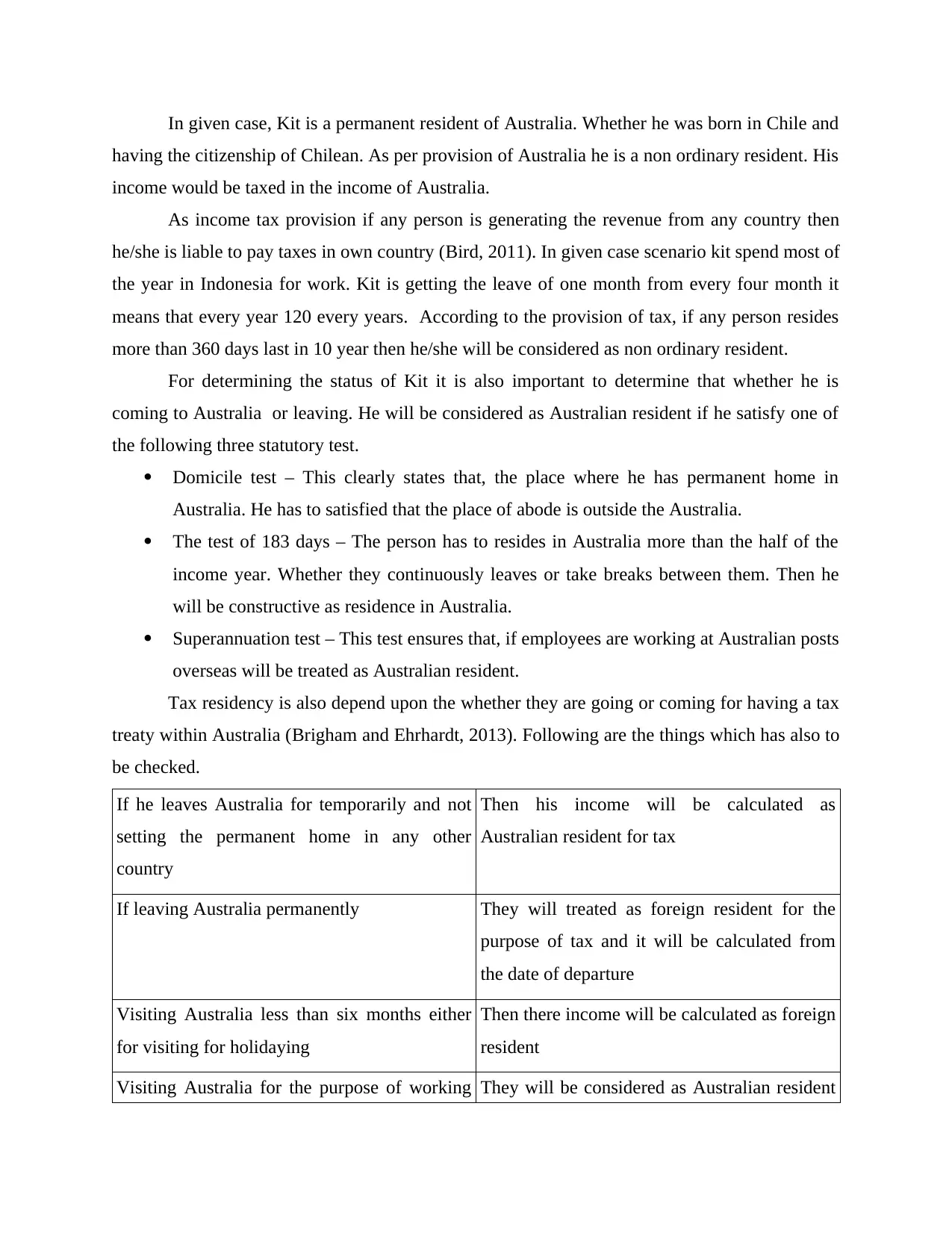
In given case, Kit is a permanent resident of Australia. Whether he was born in Chile and
having the citizenship of Chilean. As per provision of Australia he is a non ordinary resident. His
income would be taxed in the income of Australia.
As income tax provision if any person is generating the revenue from any country then
he/she is liable to pay taxes in own country (Bird, 2011). In given case scenario kit spend most of
the year in Indonesia for work. Kit is getting the leave of one month from every four month it
means that every year 120 every years. According to the provision of tax, if any person resides
more than 360 days last in 10 year then he/she will be considered as non ordinary resident.
For determining the status of Kit it is also important to determine that whether he is
coming to Australia or leaving. He will be considered as Australian resident if he satisfy one of
the following three statutory test.
Domicile test – This clearly states that, the place where he has permanent home in
Australia. He has to satisfied that the place of abode is outside the Australia.
The test of 183 days – The person has to resides in Australia more than the half of the
income year. Whether they continuously leaves or take breaks between them. Then he
will be constructive as residence in Australia.
Superannuation test – This test ensures that, if employees are working at Australian posts
overseas will be treated as Australian resident.
Tax residency is also depend upon the whether they are going or coming for having a tax
treaty within Australia (Brigham and Ehrhardt, 2013). Following are the things which has also to
be checked.
If he leaves Australia for temporarily and not
setting the permanent home in any other
country
Then his income will be calculated as
Australian resident for tax
If leaving Australia permanently They will treated as foreign resident for the
purpose of tax and it will be calculated from
the date of departure
Visiting Australia less than six months either
for visiting for holidaying
Then there income will be calculated as foreign
resident
Visiting Australia for the purpose of working They will be considered as Australian resident
having the citizenship of Chilean. As per provision of Australia he is a non ordinary resident. His
income would be taxed in the income of Australia.
As income tax provision if any person is generating the revenue from any country then
he/she is liable to pay taxes in own country (Bird, 2011). In given case scenario kit spend most of
the year in Indonesia for work. Kit is getting the leave of one month from every four month it
means that every year 120 every years. According to the provision of tax, if any person resides
more than 360 days last in 10 year then he/she will be considered as non ordinary resident.
For determining the status of Kit it is also important to determine that whether he is
coming to Australia or leaving. He will be considered as Australian resident if he satisfy one of
the following three statutory test.
Domicile test – This clearly states that, the place where he has permanent home in
Australia. He has to satisfied that the place of abode is outside the Australia.
The test of 183 days – The person has to resides in Australia more than the half of the
income year. Whether they continuously leaves or take breaks between them. Then he
will be constructive as residence in Australia.
Superannuation test – This test ensures that, if employees are working at Australian posts
overseas will be treated as Australian resident.
Tax residency is also depend upon the whether they are going or coming for having a tax
treaty within Australia (Brigham and Ehrhardt, 2013). Following are the things which has also to
be checked.
If he leaves Australia for temporarily and not
setting the permanent home in any other
country
Then his income will be calculated as
Australian resident for tax
If leaving Australia permanently They will treated as foreign resident for the
purpose of tax and it will be calculated from
the date of departure
Visiting Australia less than six months either
for visiting for holidaying
Then there income will be calculated as foreign
resident
Visiting Australia for the purpose of working They will be considered as Australian resident
Secure Best Marks with AI Grader
Need help grading? Try our AI Grader for instant feedback on your assignments.
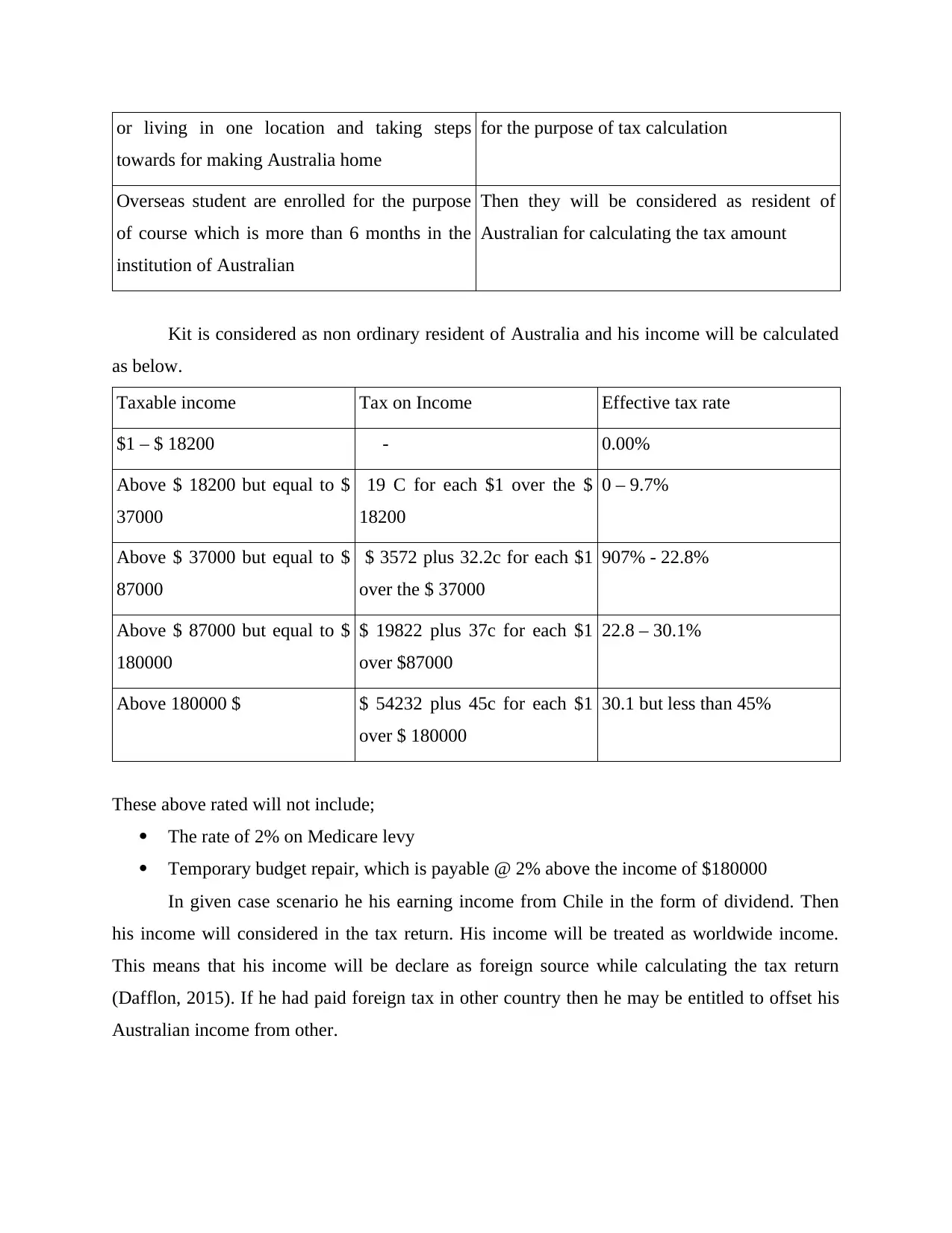
or living in one location and taking steps
towards for making Australia home
for the purpose of tax calculation
Overseas student are enrolled for the purpose
of course which is more than 6 months in the
institution of Australian
Then they will be considered as resident of
Australian for calculating the tax amount
Kit is considered as non ordinary resident of Australia and his income will be calculated
as below.
Taxable income Tax on Income Effective tax rate
$1 – $ 18200 - 0.00%
Above $ 18200 but equal to $
37000
19 C for each $1 over the $
18200
0 – 9.7%
Above $ 37000 but equal to $
87000
$ 3572 plus 32.2c for each $1
over the $ 37000
907% - 22.8%
Above $ 87000 but equal to $
180000
$ 19822 plus 37c for each $1
over $87000
22.8 – 30.1%
Above 180000 $ $ 54232 plus 45c for each $1
over $ 180000
30.1 but less than 45%
These above rated will not include;
The rate of 2% on Medicare levy
Temporary budget repair, which is payable @ 2% above the income of $180000
In given case scenario he his earning income from Chile in the form of dividend. Then
his income will considered in the tax return. His income will be treated as worldwide income.
This means that his income will be declare as foreign source while calculating the tax return
(Dafflon, 2015). If he had paid foreign tax in other country then he may be entitled to offset his
Australian income from other.
towards for making Australia home
for the purpose of tax calculation
Overseas student are enrolled for the purpose
of course which is more than 6 months in the
institution of Australian
Then they will be considered as resident of
Australian for calculating the tax amount
Kit is considered as non ordinary resident of Australia and his income will be calculated
as below.
Taxable income Tax on Income Effective tax rate
$1 – $ 18200 - 0.00%
Above $ 18200 but equal to $
37000
19 C for each $1 over the $
18200
0 – 9.7%
Above $ 37000 but equal to $
87000
$ 3572 plus 32.2c for each $1
over the $ 37000
907% - 22.8%
Above $ 87000 but equal to $
180000
$ 19822 plus 37c for each $1
over $87000
22.8 – 30.1%
Above 180000 $ $ 54232 plus 45c for each $1
over $ 180000
30.1 but less than 45%
These above rated will not include;
The rate of 2% on Medicare levy
Temporary budget repair, which is payable @ 2% above the income of $180000
In given case scenario he his earning income from Chile in the form of dividend. Then
his income will considered in the tax return. His income will be treated as worldwide income.
This means that his income will be declare as foreign source while calculating the tax return
(Dafflon, 2015). If he had paid foreign tax in other country then he may be entitled to offset his
Australian income from other.
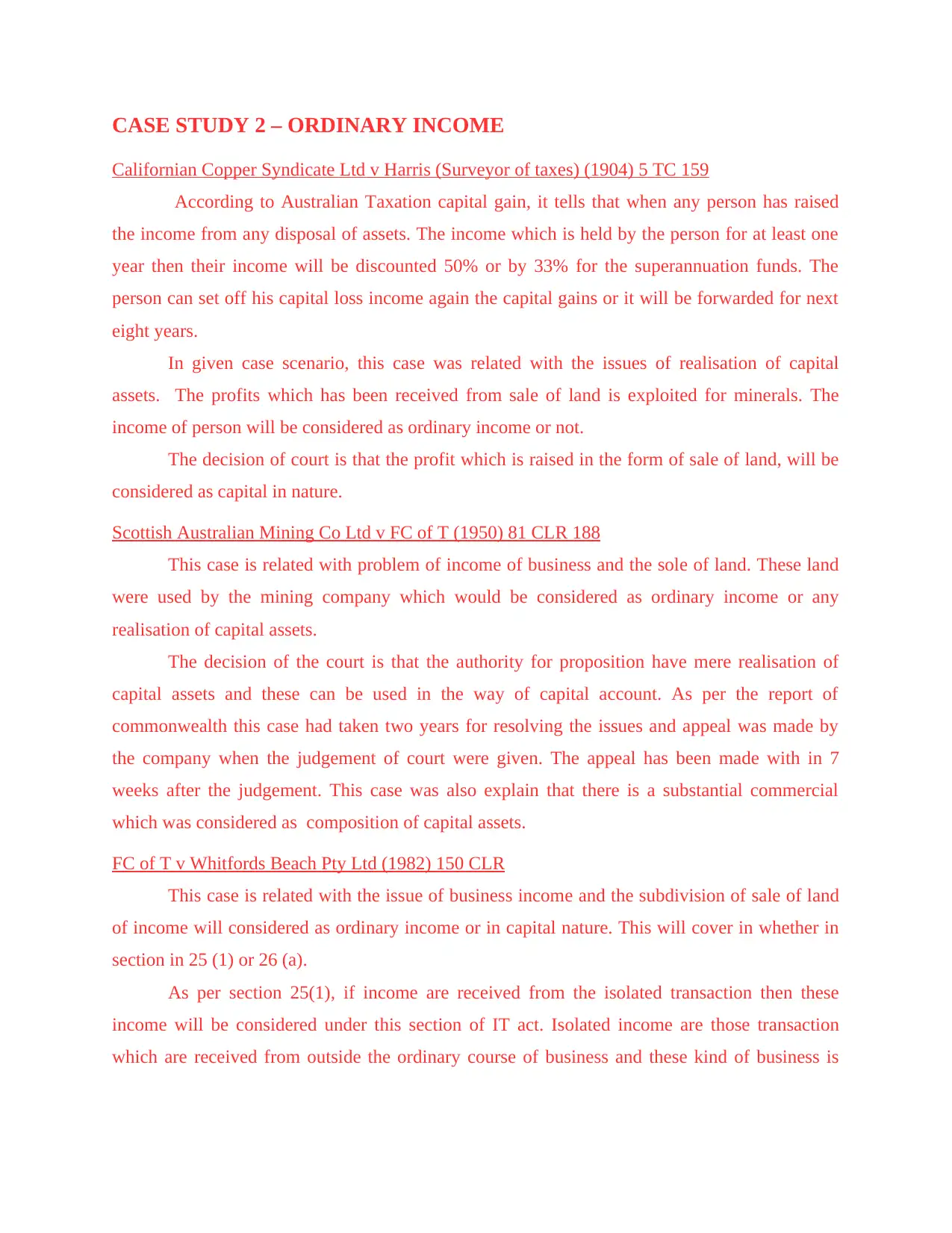
CASE STUDY 2 – ORDINARY INCOME
Californian Copper Syndicate Ltd v Harris (Surveyor of taxes) (1904) 5 TC 159
According to Australian Taxation capital gain, it tells that when any person has raised
the income from any disposal of assets. The income which is held by the person for at least one
year then their income will be discounted 50% or by 33% for the superannuation funds. The
person can set off his capital loss income again the capital gains or it will be forwarded for next
eight years.
In given case scenario, this case was related with the issues of realisation of capital
assets. The profits which has been received from sale of land is exploited for minerals. The
income of person will be considered as ordinary income or not.
The decision of court is that the profit which is raised in the form of sale of land, will be
considered as capital in nature.
Scottish Australian Mining Co Ltd v FC of T (1950) 81 CLR 188
This case is related with problem of income of business and the sole of land. These land
were used by the mining company which would be considered as ordinary income or any
realisation of capital assets.
The decision of the court is that the authority for proposition have mere realisation of
capital assets and these can be used in the way of capital account. As per the report of
commonwealth this case had taken two years for resolving the issues and appeal was made by
the company when the judgement of court were given. The appeal has been made with in 7
weeks after the judgement. This case was also explain that there is a substantial commercial
which was considered as composition of capital assets.
FC of T v Whitfords Beach Pty Ltd (1982) 150 CLR
This case is related with the issue of business income and the subdivision of sale of land
of income will considered as ordinary income or in capital nature. This will cover in whether in
section in 25 (1) or 26 (a).
As per section 25(1), if income are received from the isolated transaction then these
income will be considered under this section of IT act. Isolated income are those transaction
which are received from outside the ordinary course of business and these kind of business is
Californian Copper Syndicate Ltd v Harris (Surveyor of taxes) (1904) 5 TC 159
According to Australian Taxation capital gain, it tells that when any person has raised
the income from any disposal of assets. The income which is held by the person for at least one
year then their income will be discounted 50% or by 33% for the superannuation funds. The
person can set off his capital loss income again the capital gains or it will be forwarded for next
eight years.
In given case scenario, this case was related with the issues of realisation of capital
assets. The profits which has been received from sale of land is exploited for minerals. The
income of person will be considered as ordinary income or not.
The decision of court is that the profit which is raised in the form of sale of land, will be
considered as capital in nature.
Scottish Australian Mining Co Ltd v FC of T (1950) 81 CLR 188
This case is related with problem of income of business and the sole of land. These land
were used by the mining company which would be considered as ordinary income or any
realisation of capital assets.
The decision of the court is that the authority for proposition have mere realisation of
capital assets and these can be used in the way of capital account. As per the report of
commonwealth this case had taken two years for resolving the issues and appeal was made by
the company when the judgement of court were given. The appeal has been made with in 7
weeks after the judgement. This case was also explain that there is a substantial commercial
which was considered as composition of capital assets.
FC of T v Whitfords Beach Pty Ltd (1982) 150 CLR
This case is related with the issue of business income and the subdivision of sale of land
of income will considered as ordinary income or in capital nature. This will cover in whether in
section in 25 (1) or 26 (a).
As per section 25(1), if income are received from the isolated transaction then these
income will be considered under this section of IT act. Isolated income are those transaction
which are received from outside the ordinary course of business and these kind of business is
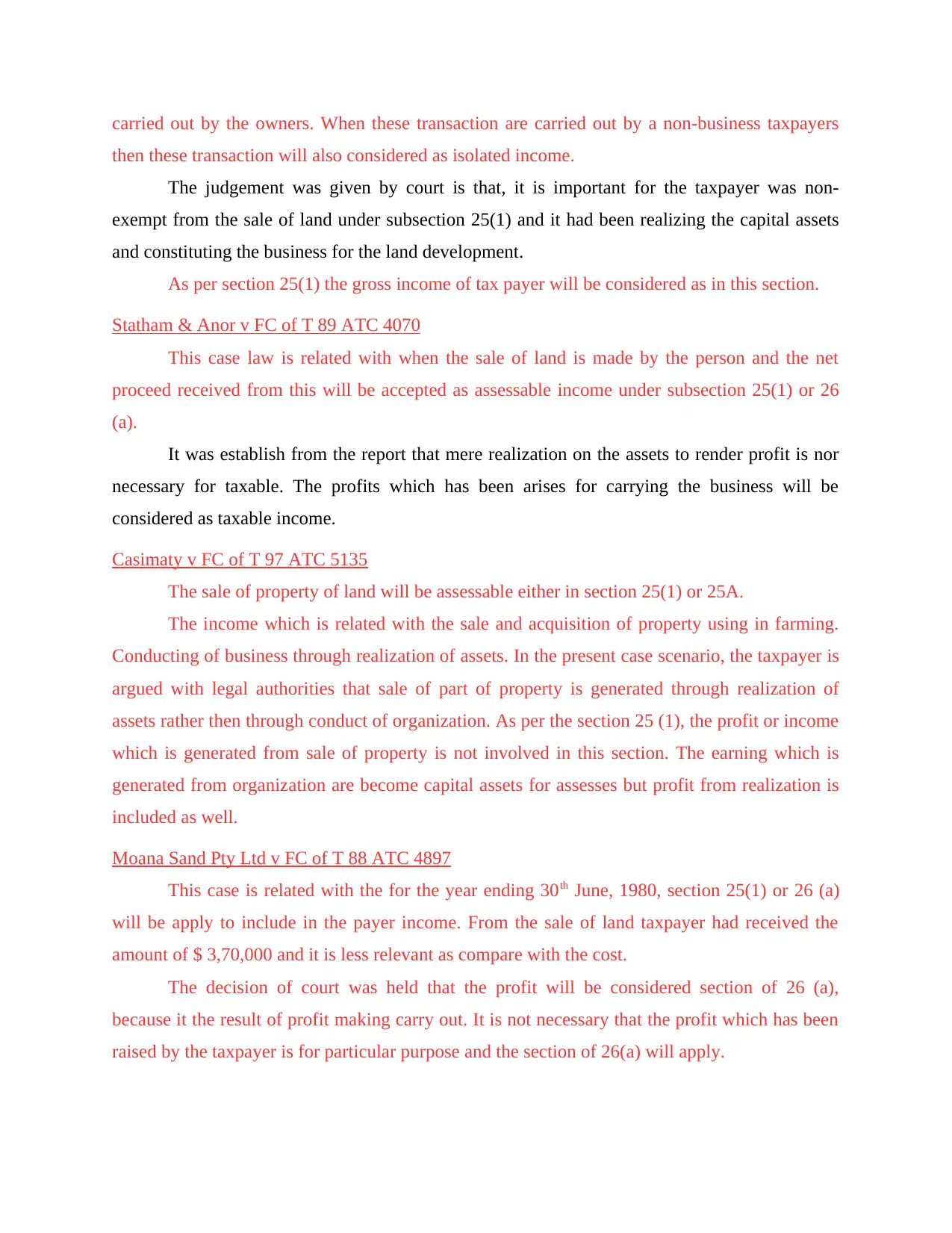
carried out by the owners. When these transaction are carried out by a non-business taxpayers
then these transaction will also considered as isolated income.
The judgement was given by court is that, it is important for the taxpayer was non-
exempt from the sale of land under subsection 25(1) and it had been realizing the capital assets
and constituting the business for the land development.
As per section 25(1) the gross income of tax payer will be considered as in this section.
Statham & Anor v FC of T 89 ATC 4070
This case law is related with when the sale of land is made by the person and the net
proceed received from this will be accepted as assessable income under subsection 25(1) or 26
(a).
It was establish from the report that mere realization on the assets to render profit is nor
necessary for taxable. The profits which has been arises for carrying the business will be
considered as taxable income.
Casimaty v FC of T 97 ATC 5135
The sale of property of land will be assessable either in section 25(1) or 25A.
The income which is related with the sale and acquisition of property using in farming.
Conducting of business through realization of assets. In the present case scenario, the taxpayer is
argued with legal authorities that sale of part of property is generated through realization of
assets rather then through conduct of organization. As per the section 25 (1), the profit or income
which is generated from sale of property is not involved in this section. The earning which is
generated from organization are become capital assets for assesses but profit from realization is
included as well.
Moana Sand Pty Ltd v FC of T 88 ATC 4897
This case is related with the for the year ending 30th June, 1980, section 25(1) or 26 (a)
will be apply to include in the payer income. From the sale of land taxpayer had received the
amount of $ 3,70,000 and it is less relevant as compare with the cost.
The decision of court was held that the profit will be considered section of 26 (a),
because it the result of profit making carry out. It is not necessary that the profit which has been
raised by the taxpayer is for particular purpose and the section of 26(a) will apply.
then these transaction will also considered as isolated income.
The judgement was given by court is that, it is important for the taxpayer was non-
exempt from the sale of land under subsection 25(1) and it had been realizing the capital assets
and constituting the business for the land development.
As per section 25(1) the gross income of tax payer will be considered as in this section.
Statham & Anor v FC of T 89 ATC 4070
This case law is related with when the sale of land is made by the person and the net
proceed received from this will be accepted as assessable income under subsection 25(1) or 26
(a).
It was establish from the report that mere realization on the assets to render profit is nor
necessary for taxable. The profits which has been arises for carrying the business will be
considered as taxable income.
Casimaty v FC of T 97 ATC 5135
The sale of property of land will be assessable either in section 25(1) or 25A.
The income which is related with the sale and acquisition of property using in farming.
Conducting of business through realization of assets. In the present case scenario, the taxpayer is
argued with legal authorities that sale of part of property is generated through realization of
assets rather then through conduct of organization. As per the section 25 (1), the profit or income
which is generated from sale of property is not involved in this section. The earning which is
generated from organization are become capital assets for assesses but profit from realization is
included as well.
Moana Sand Pty Ltd v FC of T 88 ATC 4897
This case is related with the for the year ending 30th June, 1980, section 25(1) or 26 (a)
will be apply to include in the payer income. From the sale of land taxpayer had received the
amount of $ 3,70,000 and it is less relevant as compare with the cost.
The decision of court was held that the profit will be considered section of 26 (a),
because it the result of profit making carry out. It is not necessary that the profit which has been
raised by the taxpayer is for particular purpose and the section of 26(a) will apply.
Paraphrase This Document
Need a fresh take? Get an instant paraphrase of this document with our AI Paraphraser
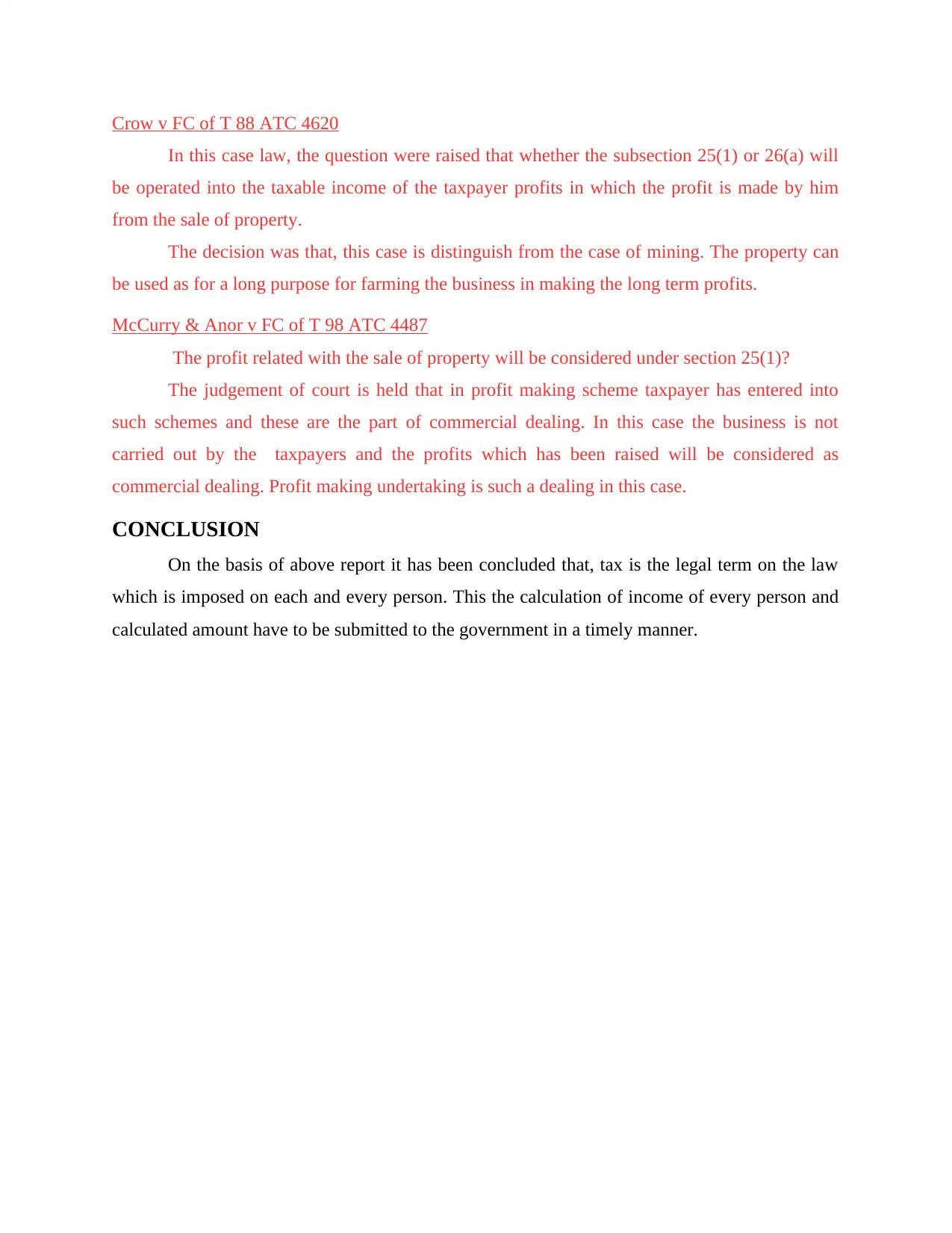
Crow v FC of T 88 ATC 4620
In this case law, the question were raised that whether the subsection 25(1) or 26(a) will
be operated into the taxable income of the taxpayer profits in which the profit is made by him
from the sale of property.
The decision was that, this case is distinguish from the case of mining. The property can
be used as for a long purpose for farming the business in making the long term profits.
McCurry & Anor v FC of T 98 ATC 4487
The profit related with the sale of property will be considered under section 25(1)?
The judgement of court is held that in profit making scheme taxpayer has entered into
such schemes and these are the part of commercial dealing. In this case the business is not
carried out by the taxpayers and the profits which has been raised will be considered as
commercial dealing. Profit making undertaking is such a dealing in this case.
CONCLUSION
On the basis of above report it has been concluded that, tax is the legal term on the law
which is imposed on each and every person. This the calculation of income of every person and
calculated amount have to be submitted to the government in a timely manner.
In this case law, the question were raised that whether the subsection 25(1) or 26(a) will
be operated into the taxable income of the taxpayer profits in which the profit is made by him
from the sale of property.
The decision was that, this case is distinguish from the case of mining. The property can
be used as for a long purpose for farming the business in making the long term profits.
McCurry & Anor v FC of T 98 ATC 4487
The profit related with the sale of property will be considered under section 25(1)?
The judgement of court is held that in profit making scheme taxpayer has entered into
such schemes and these are the part of commercial dealing. In this case the business is not
carried out by the taxpayers and the profits which has been raised will be considered as
commercial dealing. Profit making undertaking is such a dealing in this case.
CONCLUSION
On the basis of above report it has been concluded that, tax is the legal term on the law
which is imposed on each and every person. This the calculation of income of every person and
calculated amount have to be submitted to the government in a timely manner.
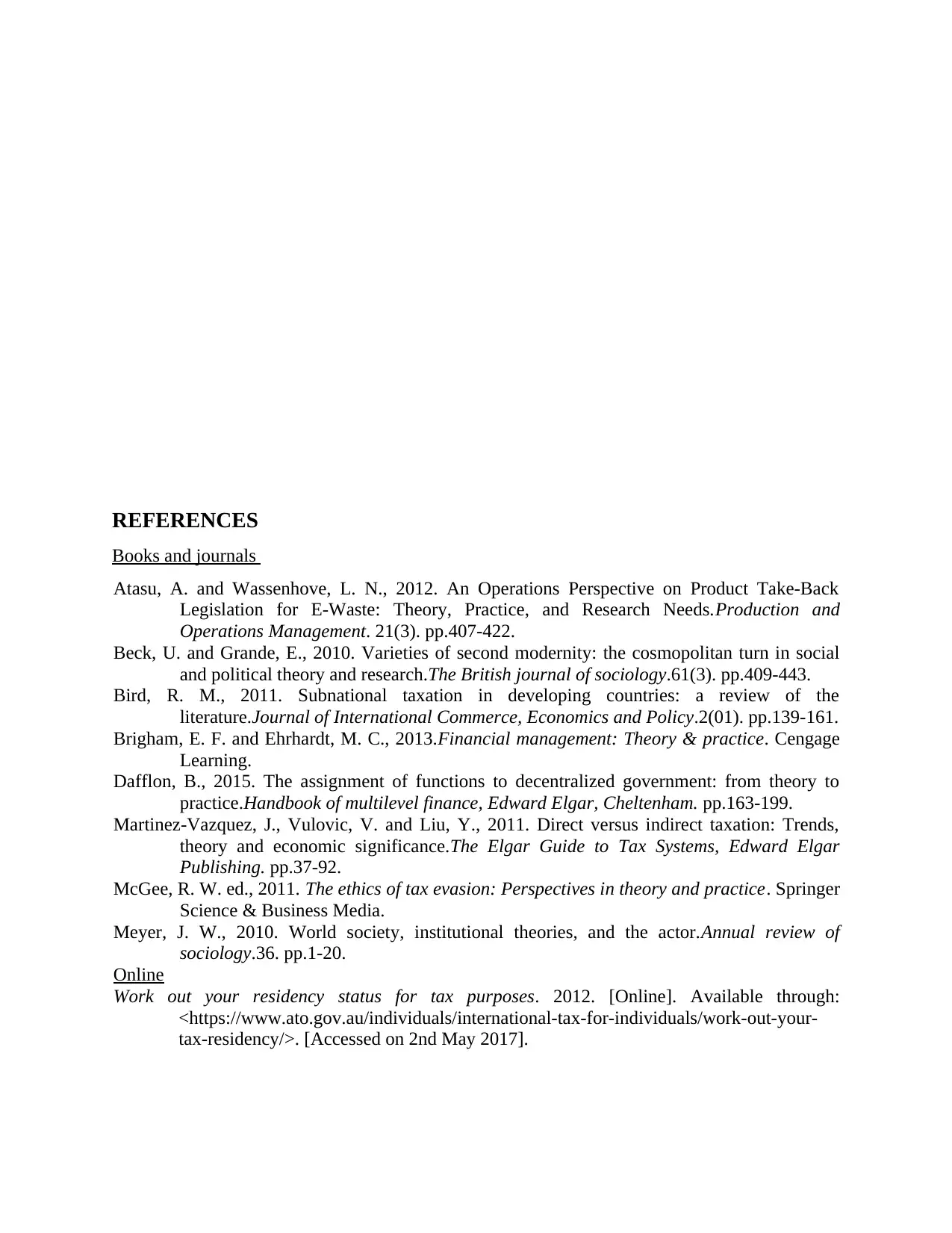
REFERENCES
Books and journals
Atasu, A. and Wassenhove, L. N., 2012. An Operations Perspective on Product Take‐Back
Legislation for E‐Waste: Theory, Practice, and Research Needs.Production and
Operations Management. 21(3). pp.407-422.
Beck, U. and Grande, E., 2010. Varieties of second modernity: the cosmopolitan turn in social
and political theory and research.The British journal of sociology.61(3). pp.409-443.
Bird, R. M., 2011. Subnational taxation in developing countries: a review of the
literature.Journal of International Commerce, Economics and Policy.2(01). pp.139-161.
Brigham, E. F. and Ehrhardt, M. C., 2013.Financial management: Theory & practice. Cengage
Learning.
Dafflon, B., 2015. The assignment of functions to decentralized government: from theory to
practice.Handbook of multilevel finance, Edward Elgar, Cheltenham. pp.163-199.
Martinez-Vazquez, J., Vulovic, V. and Liu, Y., 2011. Direct versus indirect taxation: Trends,
theory and economic significance.The Elgar Guide to Tax Systems, Edward Elgar
Publishing. pp.37-92.
McGee, R. W. ed., 2011. The ethics of tax evasion: Perspectives in theory and practice. Springer
Science & Business Media.
Meyer, J. W., 2010. World society, institutional theories, and the actor.Annual review of
sociology.36. pp.1-20.
Online
Work out your residency status for tax purposes. 2012. [Online]. Available through:
<https://www.ato.gov.au/individuals/international-tax-for-individuals/work-out-your-
tax-residency/>. [Accessed on 2nd May 2017].
Books and journals
Atasu, A. and Wassenhove, L. N., 2012. An Operations Perspective on Product Take‐Back
Legislation for E‐Waste: Theory, Practice, and Research Needs.Production and
Operations Management. 21(3). pp.407-422.
Beck, U. and Grande, E., 2010. Varieties of second modernity: the cosmopolitan turn in social
and political theory and research.The British journal of sociology.61(3). pp.409-443.
Bird, R. M., 2011. Subnational taxation in developing countries: a review of the
literature.Journal of International Commerce, Economics and Policy.2(01). pp.139-161.
Brigham, E. F. and Ehrhardt, M. C., 2013.Financial management: Theory & practice. Cengage
Learning.
Dafflon, B., 2015. The assignment of functions to decentralized government: from theory to
practice.Handbook of multilevel finance, Edward Elgar, Cheltenham. pp.163-199.
Martinez-Vazquez, J., Vulovic, V. and Liu, Y., 2011. Direct versus indirect taxation: Trends,
theory and economic significance.The Elgar Guide to Tax Systems, Edward Elgar
Publishing. pp.37-92.
McGee, R. W. ed., 2011. The ethics of tax evasion: Perspectives in theory and practice. Springer
Science & Business Media.
Meyer, J. W., 2010. World society, institutional theories, and the actor.Annual review of
sociology.36. pp.1-20.
Online
Work out your residency status for tax purposes. 2012. [Online]. Available through:
<https://www.ato.gov.au/individuals/international-tax-for-individuals/work-out-your-
tax-residency/>. [Accessed on 2nd May 2017].
1 out of 9
Related Documents
Your All-in-One AI-Powered Toolkit for Academic Success.
+13062052269
info@desklib.com
Available 24*7 on WhatsApp / Email
![[object Object]](/_next/static/media/star-bottom.7253800d.svg)
Unlock your academic potential
© 2024 | Zucol Services PVT LTD | All rights reserved.





